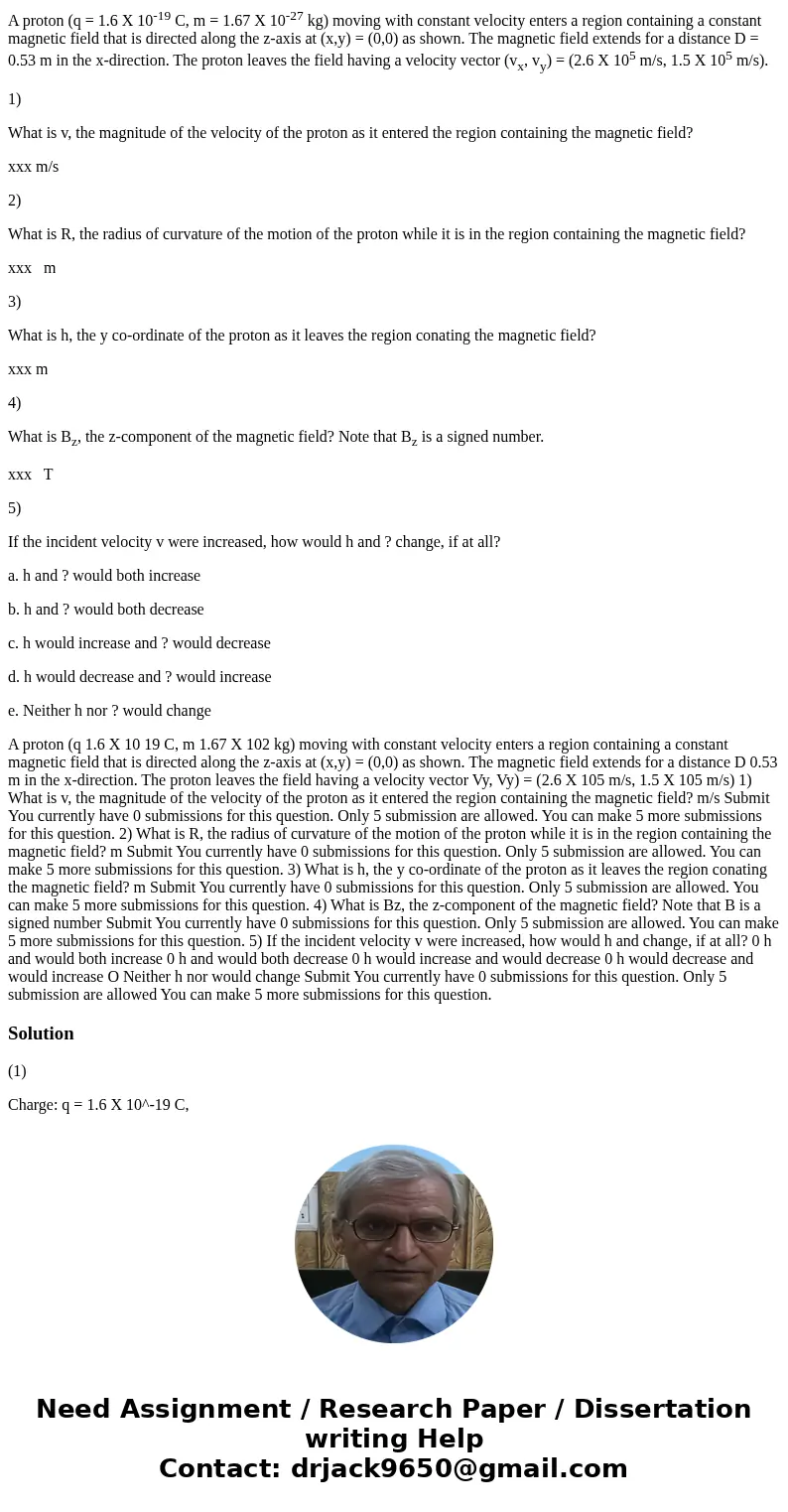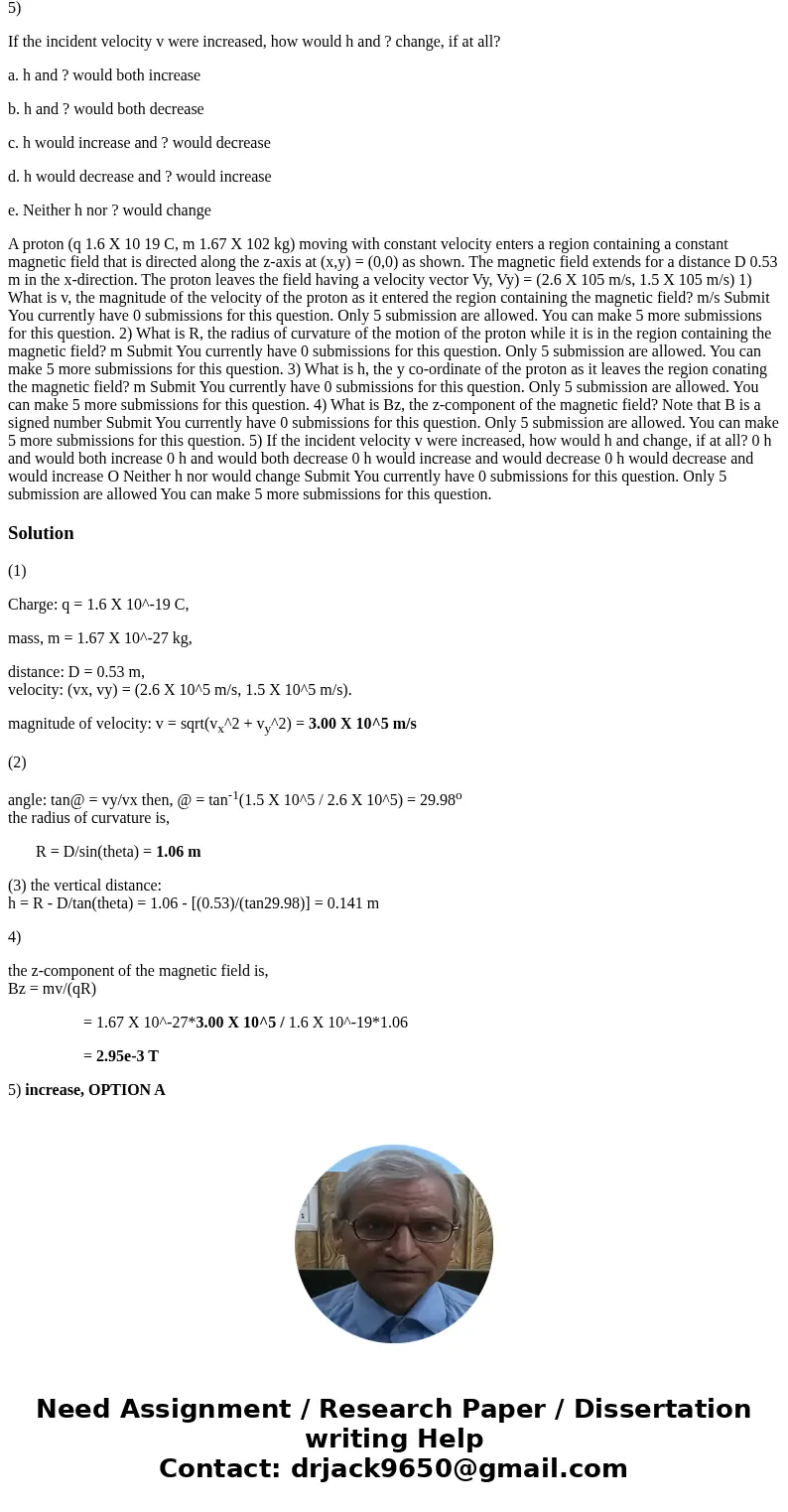A proton q 16 X 1019 C m 167 X 1027 kg moving with constan
A proton (q = 1.6 X 10-19 C, m = 1.67 X 10-27 kg) moving with constant velocity enters a region containing a constant magnetic field that is directed along the z-axis at (x,y) = (0,0) as shown. The magnetic field extends for a distance D = 0.53 m in the x-direction. The proton leaves the field having a velocity vector (vx, vy) = (2.6 X 105 m/s, 1.5 X 105 m/s).
1)
What is v, the magnitude of the velocity of the proton as it entered the region containing the magnetic field?
xxx m/s
2)
What is R, the radius of curvature of the motion of the proton while it is in the region containing the magnetic field?
xxx m
3)
What is h, the y co-ordinate of the proton as it leaves the region conating the magnetic field?
xxx m
4)
What is Bz, the z-component of the magnetic field? Note that Bz is a signed number.
xxx T
5)
If the incident velocity v were increased, how would h and ? change, if at all?
a. h and ? would both increase
b. h and ? would both decrease
c. h would increase and ? would decrease
d. h would decrease and ? would increase
e. Neither h nor ? would change
A proton (q 1.6 X 10 19 C, m 1.67 X 102 kg) moving with constant velocity enters a region containing a constant magnetic field that is directed along the z-axis at (x,y) = (0,0) as shown. The magnetic field extends for a distance D 0.53 m in the x-direction. The proton leaves the field having a velocity vector Vy, Vy) = (2.6 X 105 m/s, 1.5 X 105 m/s) 1) What is v, the magnitude of the velocity of the proton as it entered the region containing the magnetic field? m/s Submit You currently have 0 submissions for this question. Only 5 submission are allowed. You can make 5 more submissions for this question. 2) What is R, the radius of curvature of the motion of the proton while it is in the region containing the magnetic field? m Submit You currently have 0 submissions for this question. Only 5 submission are allowed. You can make 5 more submissions for this question. 3) What is h, the y co-ordinate of the proton as it leaves the region conating the magnetic field? m Submit You currently have 0 submissions for this question. Only 5 submission are allowed. You can make 5 more submissions for this question. 4) What is Bz, the z-component of the magnetic field? Note that B is a signed number Submit You currently have 0 submissions for this question. Only 5 submission are allowed. You can make 5 more submissions for this question. 5) If the incident velocity v were increased, how would h and change, if at all? 0 h and would both increase 0 h and would both decrease 0 h would increase and would decrease 0 h would decrease and would increase O Neither h nor would change Submit You currently have 0 submissions for this question. Only 5 submission are allowed You can make 5 more submissions for this question.Solution
(1)
Charge: q = 1.6 X 10^-19 C,
mass, m = 1.67 X 10^-27 kg,
distance: D = 0.53 m,
velocity: (vx, vy) = (2.6 X 10^5 m/s, 1.5 X 10^5 m/s).
magnitude of velocity: v = sqrt(vx^2 + vy^2) = 3.00 X 10^5 m/s
(2)
angle: tan@ = vy/vx then, @ = tan-1(1.5 X 10^5 / 2.6 X 10^5) = 29.98o
the radius of curvature is,
R = D/sin(theta) = 1.06 m
(3) the vertical distance:
h = R - D/tan(theta) = 1.06 - [(0.53)/(tan29.98)] = 0.141 m
4)
the z-component of the magnetic field is,
Bz = mv/(qR)
= 1.67 X 10^-27*3.00 X 10^5 / 1.6 X 10^-19*1.06
= 2.95e-3 T
5) increase, OPTION A


 Homework Sourse
Homework Sourse